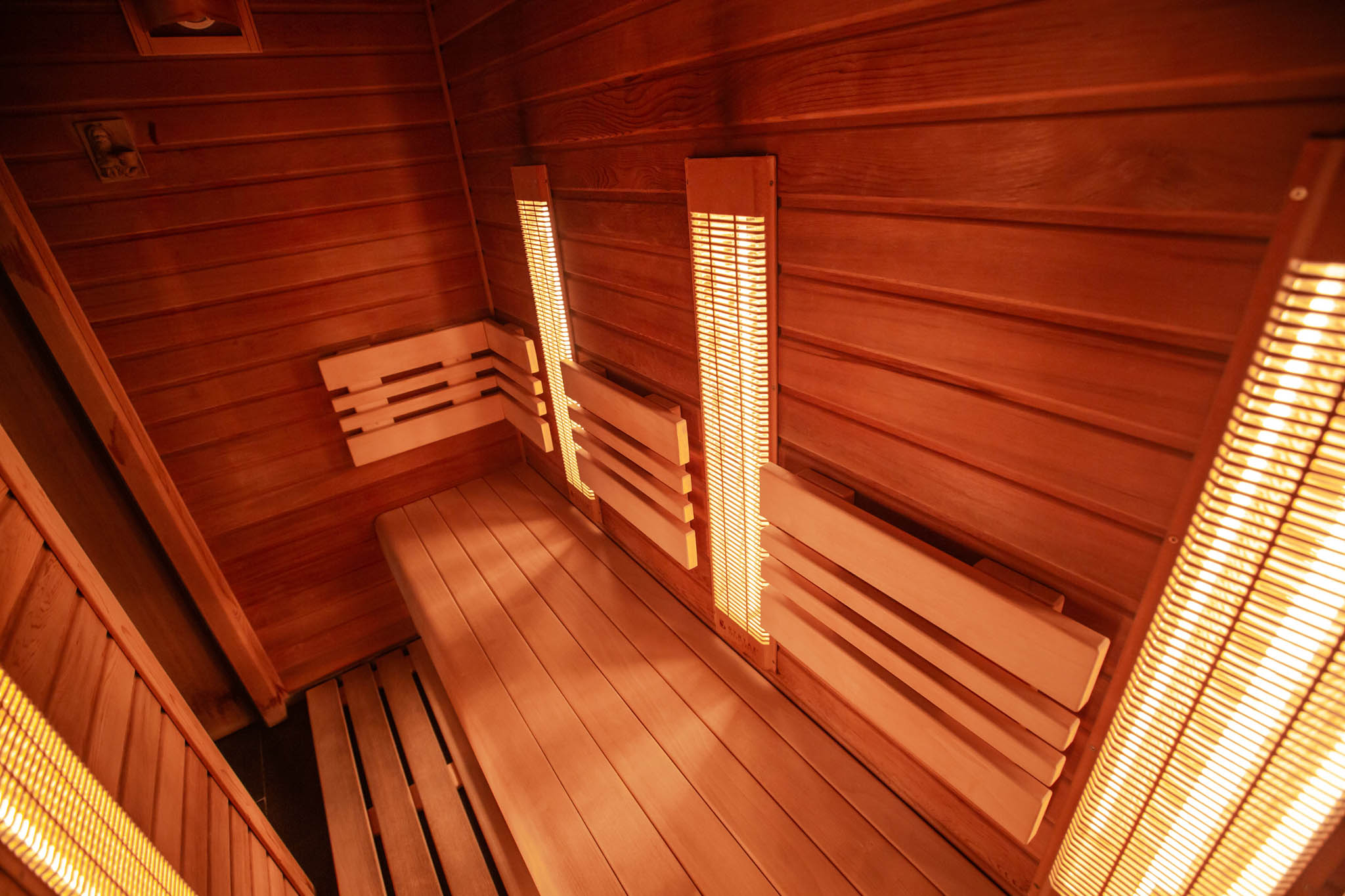
The Healing Power of Infrared Saunas
Saunas are one of the most popular forms of heat therapy, valued for their physical, mental, and even social benefits. Today, four primary types of saunas are commonly used: the traditional Finnish sauna (also known as smoke sauna or savusauna), dry saunas, steam baths (often referred to as Turkish baths or hammams), and infrared saunas.
Each option offers a unique way to experience heat therapy, but one in particular has captured modern attention for its scientific innovation and targeted approach to wellness.
Combining Light and Heat in Infrared Saunas
Infrared saunas are changing the way we think about relaxation and recovery. Unlike traditional baths that rely on coal, wood, electric heaters, or steam generators to warm the surrounding air, infrared saunas use precise wavelengths of light to heat the body directly. This difference may seem subtle, but it fundamentally changes how our bodies experience and respond to heat therapy.
Infrared light consists of multiple wavelengths that penetrate the body at different depths. When used in a sauna, these invisible lights elevate your core temperature, causing you to sweat like a traditional bath. At the same time, the light interacts with cells beneath the skin’s surface, triggering biological responses that support recovery, circulation, and overall wellness.
In this article, we’ll cover everything you need to know about infrared saunas, including how they work, the difference between near, mid, and far infrared wavelengths, and what to look for when choosing a certified provider for your light-based heat therapy.
Evolution of Sauna Therapy
Here’s a brief overview of both traditional and infrared saunas to help you better understand sauna therapy as a whole and how it has evolved into the modern treatments we know today.

Traditional Saunas
Origins and History
Traditional saunas date back over 2,000 years and have deep roots in Finnish culture. Early versions involved heating stones with fire to produce intense, dry heat for physical cleansing, relaxation, and spiritual rituals.
Over time, the design evolved to include steam rooms and electric heating, but the fundamental concept of high-heat therapy remained the same.
Benefits of Traditional Saunas
- Flush Toxins: Saunas induce heavy sweating, which can assist in the elimination of small amounts of toxins, such as heavy metals and certain environmental pollutants. However, it's important to note that sweating is not the body's primary method for detoxification; organs like the liver and kidneys play a more significant role in this process.
- Muscle Pain Relief: Saunas' high temperatures can increase blood flow and relax tight or sore muscles, making them a popular choice for post-exercise recovery. This heat exposure may help reduce muscle tension and perceived pain, particularly for temporary strains or overuse.
- Support Cardiovascular Health: Frequent sauna use has been associated with improved circulation and cardiovascular function, partly because heat causes blood vessels to open and the heart rate to rise. This cardiovascular stimulation can mimic the effects of mild to moderate aerobic exercise and may contribute to improved heart health over time. 1
- Relaxation: The soothing heat of a sauna can promote mental and physical relaxation, and some studies suggest it may help lower cortisol levels–the body’s primary stress hormone. However, this varies depending on personal tolerance and physiological responses, and some may find the excess heat stressful. 2 Many individuals report improved sleep and a greater sense of emotional balance following regular sauna use.
Limitations
- Extremely High Temperatures: Depending on the type of sauna and its heating method, temperatures can reach up to 190°F (88°C) or more. For some individuals, especially those with heat sensitivity or other medical concerns, these intense temperatures can feel overwhelming, uncomfortable, and dangerous if not used properly or under professional supervision.
- Less Targeted Treatment: Traditional saunas primarily affect surface-level areas of the body, like skin. Because the heat does not penetrate deeper tissues or cells, it may be less effective for certain health goals such as chronic pain management, fatigue reduction, or cellular repair.

Infrared Technology
How it Started
Using infrared light for therapeutic purposes started in the mid-20th century when researchers and medical professionals began studying the biological effects of infrared radiation on human tissues. By the 1970s, infrared technology was adapted for wellness treatments, offering a new way to deliver heat and light-based therapy.
As science matured, so did technology, leading to today’s modern infrared saunas, commonly used in clinics, spas, and homes worldwide.
Infrared Sauna Benefits
- Lower, More Manageable Temperatures: Infrared saunas typically function between 110°F and 140°F (43°C to 60°C), which is much lower than traditional sauna temperatures. This range provides a more comfortable experience for users while still inducing sweat and physiological responses similar to other saunas.
- Deeper Tissue Healing and Pain Relief: The light from infrared saunas penetrates below the skin’s surface, reaching muscles, joints, connective tissues, and individual cells. This deep-reaching warmth can stimulate biological processes that support healing, reduce inflammation, and help individuals find relief from chronic pain. A randomized controlled trial published in the National Library of Medicine found that far-infrared sauna therapy significantly reduced pain levels in patients with chronic low back pain, with noticeable improvements after just a few sessions. 3
- Non-Invasive: Infrared sauna therapy is a non-invasive treatment, meaning there are no needles, incisions, or medications involved. This makes it an appealing option for individuals seeking a gentle, natural approach to wellness without the intensity or recovery time associated with more invasive treatments.
Limitations
- Limited Standardization Across Devices: The effectiveness of infrared sauna therapy can vary depending on the emitters' quality, type, and configuration. Some may lack the proper wavelength range or output levels to deliver consistent results.
- Not Suitable for Everyone: Infrared sauna therapy may not be appropriate for individuals who are pregnant, have cardiovascular issues, are photosensitive, or take medications that affect thermoregulation. Consult a healthcare professional before use if you have any medical conditions or concerns.
The Science Behind Infrared Saunas
Infrared light is part of the electromagnetic spectrum, just beyond visible red light. It’s divided into three main categories: near-infrared (NIR), mid-infrared (MIR), and far-infrared (FIR). Each type of infrared light has unique properties that influence how deeply it penetrates the body and what therapeutic effects it may offer.
When it comes to sauna design, there are two primary types commonly used today: far-infrared saunas and full-spectrum saunas. Here’s how each one works:
Far-Infrared Saunas
Far-infrared saunas use only FIR wavelengths, typically in the range of 3,000 to 10,000 nanometers. These wavelengths are easily absorbed by water molecules in the skin, creating a gentle radiant heat that warms the body and stimulates sweating.
Because of its reliable heat delivery and relaxing thermal effect, far-infrared light is the primary heating method in all infrared saunas, including full-spectrum models.
Full-Spectrum Saunas
Full-spectrum saunas combine near-, mid-, and far-infrared wavelengths to deliver a more comprehensive therapeutic experience. The addition of NIR and MIR expands the range of benefits you can experience during your sauna session:
- Near-Infrared Light: NIR can reach deep muscle tissues, joints, and cells. It’s commonly used during red light therapy to stimulate mitochondrial activity, support cellular regeneration, and help reduce inflammation.
- Mid-Infrared Light: MIR light reaches a moderate depth, reaching soft tissues and may help increase circulation, relieve muscle tension, and support overall recovery after physical activity or stress.
Infrared Saunas vs Red Light Therapy
While infrared saunas deliver broad, whole-body exposure to therapeutic light and heat, they are not a replacement for more targeted red light therapy treatments.
Clinical-grade photobiomodulation devices, which use precise wavelengths of NIR or red light, are more appropriate for addressing specific issues like chronic joint pain, skin conditions, or localized tissue repair.

Learn More About Infrared Light Technology
Infrared light technology is one of the most exciting advancements in the wellness industry, offering a safe, non-invasive way to support your body’s natural healing and biological processes.
If you’re curious about infrared light and its applications — including saunas, therapeutic devices, or its wellness benefits — reach out to Light Lounge’s expert team. We’re happy to answer your questions and help you discover the best light therapy solutions to support your health and wellness goals.
Learn MoreCITATIONS:
- Cardiovascular and Other Health Benefits of Sauna Bathing: A Review of the Evidence
- Endocrine effects of sauna bath
- Infrared sauna in patients with rheumatoid arthritis and ankylosing spondylitis. A pilot study showing good tolerance, short-term improvement of pain and stiffness, and a trend towards long-term beneficial effects